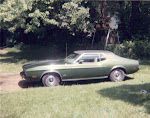The idea of using electric cars for microtransit -- short trips -- would work well around Normal. Of course, off-campus ISU students might like to use it to get to classes from their apartment and back again, and Heartland students might be willing to use it to get from distant parking lots to their classroom building (mainly on days with lousy weather). But what about other uses? Perhaps older residents would appreciate a quick trip to the mall or to a restaurant. Yes, there are taxi services in town, but e-rides could probably be offered at a lower cost because the cost of gas would not have to be included in the fare. (Slow-moving electric vehicles would not be able to travel on most town streets so would not work for around-town trips.)
Restrictions on the distance traveled per ride could eliminate the e-rides as competition for the local bus system. And many people who do not want to ride a bus for whatever reason but who only want to travel relatively short distances are a potential source of customers.
Something to consider.
Saturday, July 30, 2011
Monday, July 25, 2011
Normal Needs Some Transfer Accelerators
I like this idea: a slide (called a "transfer accelerator") next to a stairway at a train station. Something that's fun as well as useful. We could use fun ideas like this for transitioning the Constitution Trail over roads (or maybe railroad tracks?): a cool, tube-like structure that slopes gently up from one side of the road and down the other side. Walkways and stairs don't have to be boring and standardized. We are so restricted from creating fun alternatives because of the possibility of people taking unnecessary risks and suing others when those risks result in injuries. That's a shame.
Friday, July 15, 2011
Normal: Ads Underfoot?
New York City has decided to ban ads on sidewalks. Not only is it illegal to stick decal ads on sidewalks, businesses are not allowed to project their logo onto the sidewalk at night!
Maybe Normal could make some money by allowing ads on sidewalks in the business district. And, if it could bring in even more money, there could be ads on the Constitution Trail [insert moaning or rage here]. The ads could be stickers designed to last no more than one season (automatically worn off by weather), so residents would not have to see the same ads for very long (and the town would get more money for new ads).
Is the commercialism worth it? Would businesses benefit? Does anyone really look down much while walking?
Maybe Normal could make some money by allowing ads on sidewalks in the business district. And, if it could bring in even more money, there could be ads on the Constitution Trail [insert moaning or rage here]. The ads could be stickers designed to last no more than one season (automatically worn off by weather), so residents would not have to see the same ads for very long (and the town would get more money for new ads).
Is the commercialism worth it? Would businesses benefit? Does anyone really look down much while walking?
Saturday, July 9, 2011
Normal: We Need a Video!
There are wonderfully creative videos of daily life in various cities. This video of Berlin is amazing! Maybe someone could videotape life in Normal in a similar way. What kind of background music would be appropriate for such a video?
Tuesday, July 5, 2011
Normal PRTS: If only . . .
Imagine an elevated track with smallish cars (each holding 20 people) that zip from point to point without stopping. Now, imagine that track up and around Normal (and Bloomington, if they say "please"), moving people easily from place to place. There is actually such a system at West Virginia University: the only U.S. personal rapid transit system. It was developed and built by Boeing with federal money and is still being used.
Ok, so this area isn't quite so sprawling and rural (not as rural as it used to be, anyway). But it would still be a great way to transport people (not just ISU students) without using streets. The West Virginia system has a way to keep the cars moving in ice and snow, so that's no problem. But it's probably too late to integrate an elevated track around here because of all the buildings in the way (not that we have many tall ones).
It's odd that we've come back to thinking about rails again after concentrating on streets for so long. I guess everyone has given up on those flying cars of the "future."
Ok, so this area isn't quite so sprawling and rural (not as rural as it used to be, anyway). But it would still be a great way to transport people (not just ISU students) without using streets. The West Virginia system has a way to keep the cars moving in ice and snow, so that's no problem. But it's probably too late to integrate an elevated track around here because of all the buildings in the way (not that we have many tall ones).
It's odd that we've come back to thinking about rails again after concentrating on streets for so long. I guess everyone has given up on those flying cars of the "future."
Subscribe to:
Comments (Atom)






